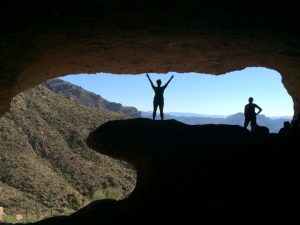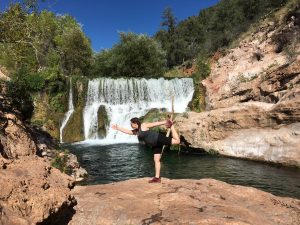9 Tips To Make Hiking More Enjoyable

1. Use your feet/ankles/toes. When hiking uphill, think of the way you get “up” the mountain as coming from your ankles, feet and toes propelling you, rather than your thighs/quads doing all the work. Another way to think of this is: Imagine your back foot pushing you forward rather than your front leg standing you up.
2. Take smaller, slower steps when hiking uphill. You want to push yourself to the point where you can keep a steady breathing pace so that you don’t have to stop to gulp for air every few steps. The way you do this is to take smaller steps, which means you might move a little slower. That’s OK! That’s how you get up the damn mountain. If it gets particularly steep, check out this video on a technique called a “rest step.” I haven’t quite figured out down hill yet, although I try to use my hips to take some of the impact off my knees (like so) and when all else fails, I have gotten pretty talented at falling.
3. Bring (a little) more water than you need. I always bring 3 liters, more like 4 (usually in the form of a gatorade/vitamin water) if I know I’ll be out for more than 5 hours, or if it’s especially hot out.
4. Bring SNACKS. In my opinion, hiking – especially backpacking – is not a dieting exercise. Your body wants fuel and it will demand it. Bring hiking bars (like Lara Bars, Kind Bars, etc) for shorter trips, and if you’re going to be out more than 3 hours, bring lunch (which you may end up eating early in the trip.) 90 percent of the time when I am grumpy and every step I take feels like the end of the world, it’s because I am low on fuel and need a snack (and probably a brief break.) Pay attention to when these things happen so with time you can learn to catch them before they make you hit a wall.
5. Start a mindfulness practice. Hiking is mostly mental. Certainly mental positivity can be easier when your calf muscles are used to the endurance of uphill hiking, but it’s still mostly a mental game. When I first started, my internal monologue was often: “I am so bad at this. I am so out of shape. Everyone is passing me. I’m never going to be as fast as them. I look like a joke. Everyone can tell that I’m new at this. I’m not meant to be outside.” Once I could *see* that I was saying those things, rather than just letting them keep talking, it’s easier to practice not believing them. I can say, “Huh, that’s not very nice,” or “That doesn’t sound entirely true.” Being able to recognize those thoughts means I’m a lot less likely to quit, turn around, or stomp along miserably for the next 3 miles.
6. Mess around with gear that’s within your budget. Although it would be nice to think that we could just find the top-rated gear online and know we have the best of the best, the truth is the best gear is the gear that works for YOU. If the top-rated shoes are giving you blisters, or they just feel weird to you, take advantage of the return policy and try something different. If all the other hikers on the trail go out there in tank tops but the sun makes you want to shrink into a hole, play around with long-sleeved options or a sun umbrella. Hiking can be made extremely cheap by hitting up Goodwill to find synthetic hiking clothes, hats and sunglasses. I’ve seen hiking and backpacking backpacks there. But if you find that the gear isn’t working for you – whether you paid $1 for it or $100 for it – give yourself the permission to try something different when you are able to afford it. You don’t know that it doesn’t work until you experience it not working. That’s OK.
7. Stretch. Admittedly this is something I’m still trying to make a habit, but it makes SUCH a difference. There are a bunch of different opinions on when to stretch (should you stretch beforehand? during? after?) and you’ll have to figure out what’s right for you – but if nothing else, stretch AFTER the hike, and then maybe even a couple of hours after you’ve stretched (like, before you go to bed.) I’m not a scientist, but it seems to remind my muscles to relax after a hike so that they’re not still clenching through the night, and that leaves me with much less soreness the next day. Here are a few good stretches specifically for hikers and backpackers.
8. Accept that sometimes hikes suck. Too hot. Too cold. Too uphill. Too rushed. Too brown. Too green. Too many people. Too lonely. Too bad an attitude. I don’t walk away from every hike with an untouchable sense of wonder, even if Instagram sometimes looks that way. Learn from the less-than-ideal hikes and tailor the next one to be a little different.
9. Hike your own hike. Do everything you can not to compare yourself to other hikers on the trail. There is no prize for being the first person to the end or for taking the shortest breaks. And when you go hiking with a friend, there’s no rule that says you have to talk the whole time or stay within a few feet of each other. As long as you’re both safe – plenty of water, low risk of hypothermia or heat stroke – let yourselves hike different paces and find a routine you’re both comfortable with to check in on each other. It can be a real fun-killer to constantly be trying to keep up with the person in front of you or wait for the person behind you. Don’t let something like different hiking speeds kill your fun.
courtesy colleen stinchcombe
The Origin & Beauty Of Yosemite National Park
















